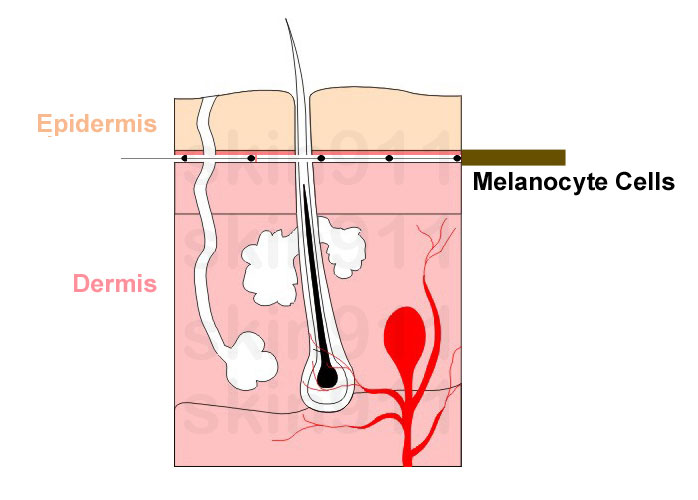
Author: Mary Gillespie
Once you try us you'll want to stay with us - discover why our customers keep coming back for more. We stand behind our products 100%. Place your order today!
I suddenly have a brown mark…what?
- The majority of melanin producing cells called "melanocytes" (me - la - no - sites) are located along the bottom layer of the epidermis injecting clear cells traveling to the surface of your skin with color called melanin. The epidermis forms the surface of your skin and is the same thickness as a silk scarf without blood vessels or nerve endings. If you cut yourself and bleed you have gone through the epidermis into the dermal layer of your skin.
- A living melanocyte cell spends its whole life giving your body its natural pigmentation or color, dead cells leave a permanent white area called hypopigmentation, and over active ones produce a color darker than your natural skin tone called hyperpigmentation. Over active cells, unlike over active children who can outgrow the condition, remain touchy for life. Albert Kligman, M.D., Ph.D, co-inventor of Retin-A, believes a brown sun spot will usually reappear after one year from "cell memory" leaving the patient on a continual or sporadic maintenance program for control.
- Caucasian and skin of color doesn’t differ in the number of melanocyte cells but with the rate and abundance of melanin being produced for color. Darker skin types produce melanin at a faster rate to darken skin - the plus being a better sun shield for aging, the minus sensitivity to injury. A mere bump on the leg, a hat or sun visor band on the forehead, or rubbing eyes from allergies will produces brown marks from the fast acting melanocyte cells.
- Hemosiderin (he-mo-sid-er-in) pigment derives its color from iron in the blood turning tissue a brownish-red copper color common in the lower legs after an injury or surgery. If the body cannot remove this pigment the discoloration or stain is permanent, no known medical treatment is available.
What we do for you…
- 2% hydroquinone bleach is a white crystalline phenol occurring in nature producing reversible skin lightening by inhibition of the enzymatic oxidation of tyrosine and suppression of other melanocyte metabolic processes … in plain English - stops the dark color without the irritation of higher strengths. Depigmentation of brown spots or areas is not immediate since bleaching ingredients such as, hydroquinone only interfere with the formation of new melanin at the cell site. The darker color already in the skin needs to migrate to the surface to be sloughed off which usually takes up to three weeks.
- Known for fast and reliable results, improving the first three weeks with continuing results, if no improvement after three months discontinue and see your doctor.
- Our exclusive products will remove, significantly improve, and control darkening by slowing the melanocyte color production until your brown areas have disappeared. Areas such as, brown spots, freckles appearing darker in summer and lighter in months with less sunlight, sun spots, brown pigmentation, melasma from oral hormones and brown discoloration in the top layer of your skin called the epidermis.
- Protect your skin with sunscreen from sun and fluorescent lights that stimulate the return of your brown spots possibly giving the impression your skin bleach is not working.
A sign it’s working…
- Occasionally, brown marks appear to turn darker as the color moves toward the surface allowing you to get a better look. Your body can take up to three weeks to slough the old dark color off the surface to reveal your natural skin tone. Keep using your skin lightener to stop new dark color from being produced at the cell site.
- Glycolic acid sloughing action will speed things up!
Skin911 skin bleach won’t…
- Improve blue, purple, red or pink vascular conditions such as, spider veins, red flushing, scars, or white areas with permanent loss of skin color.
As with any skin care product…
- Discontinue use if an allergic reaction of bright red, itchy, swollen and blistering skin occurs, more common in products containing over 2% hydroquinone. A drug store 1% hydrocortisone spray for oily skin and a cream for the rest such as, Cortaid will give you relief. Irritation and redness can be controlled by reducing daily applications to a few weekly applications until your skin adjusts, increasing applications in small increments until using at least once daily, optimal twice daily.
Interesting facts…
- Available strengths on the market are 4% and above with a doctor’s prescription, 2% from a skincare salon or licensed cosmetology professional and 1% is OTC (over the counter) common in drugstores.
- Mercury in any cosmetics or prescriptions has been banned by the United States FDA but is found in foreign skin bleaches causing concern for unaware travelers purchasing in other countries.
- Our products are manufactured in the United States.
